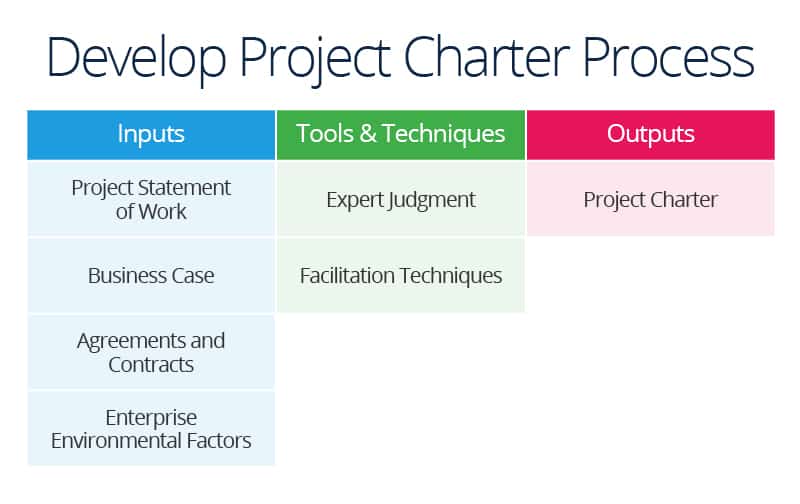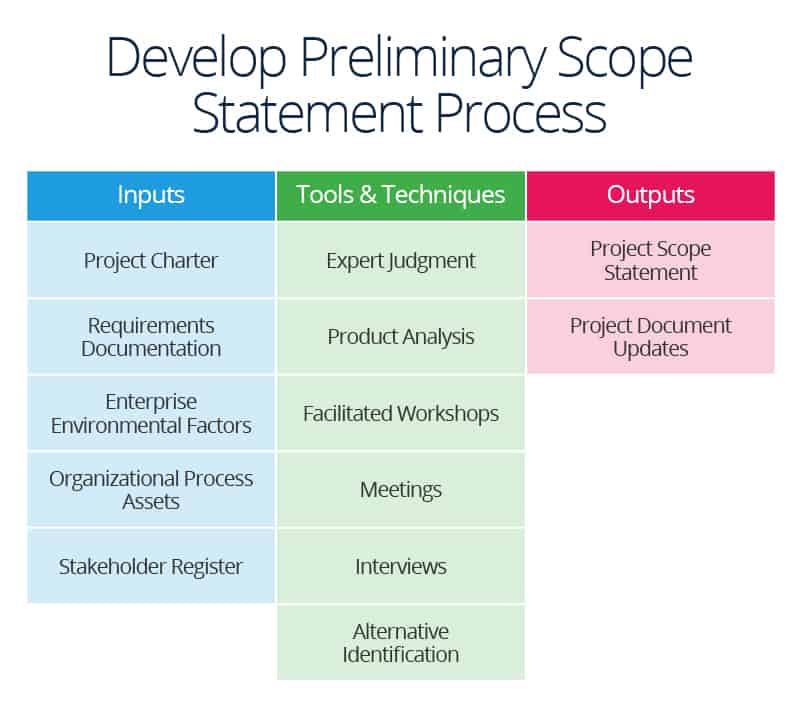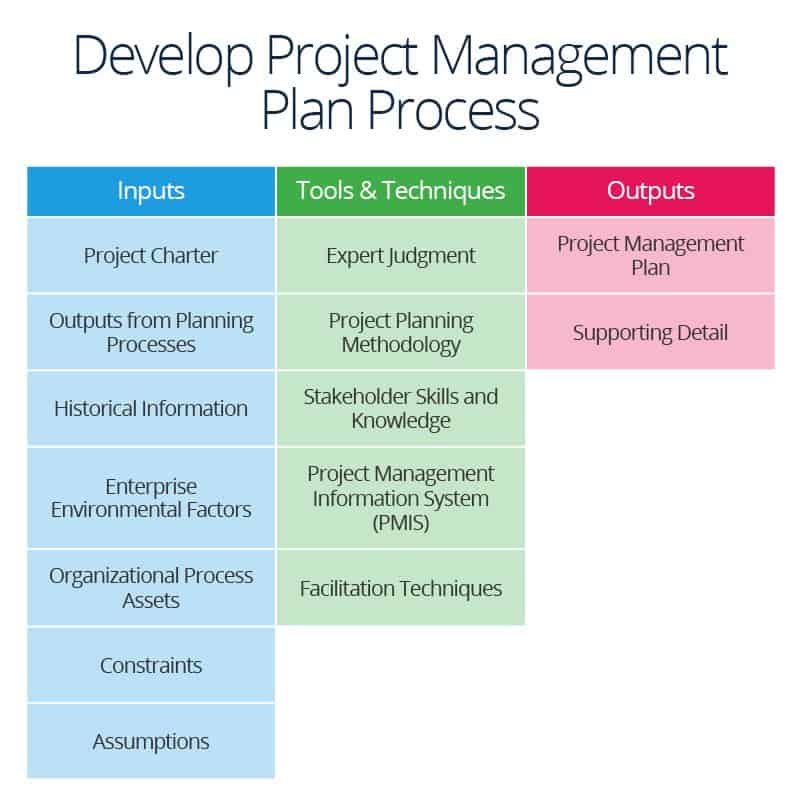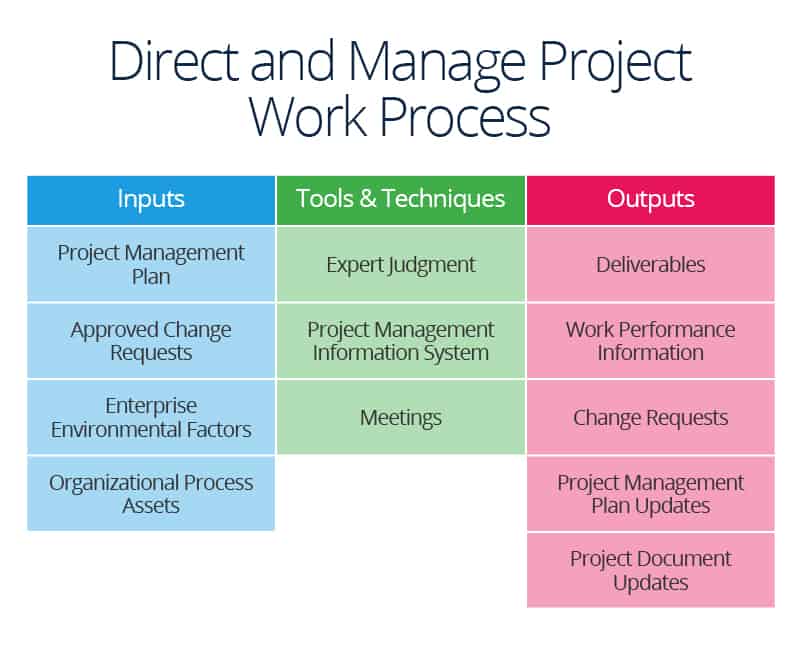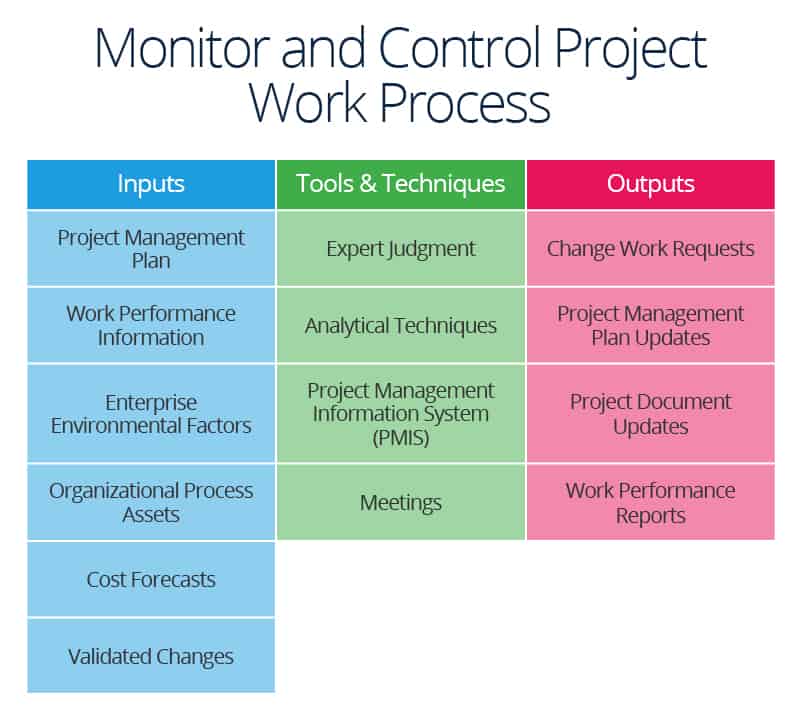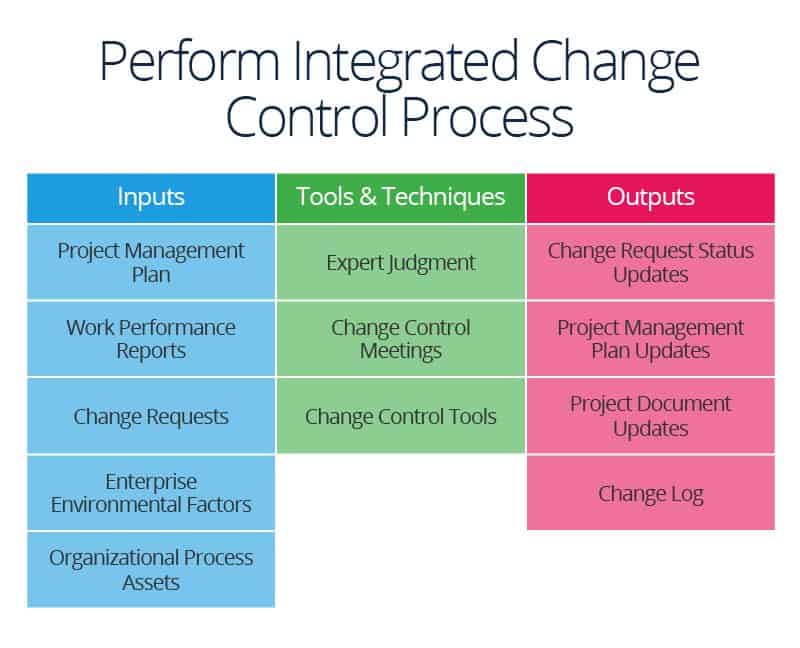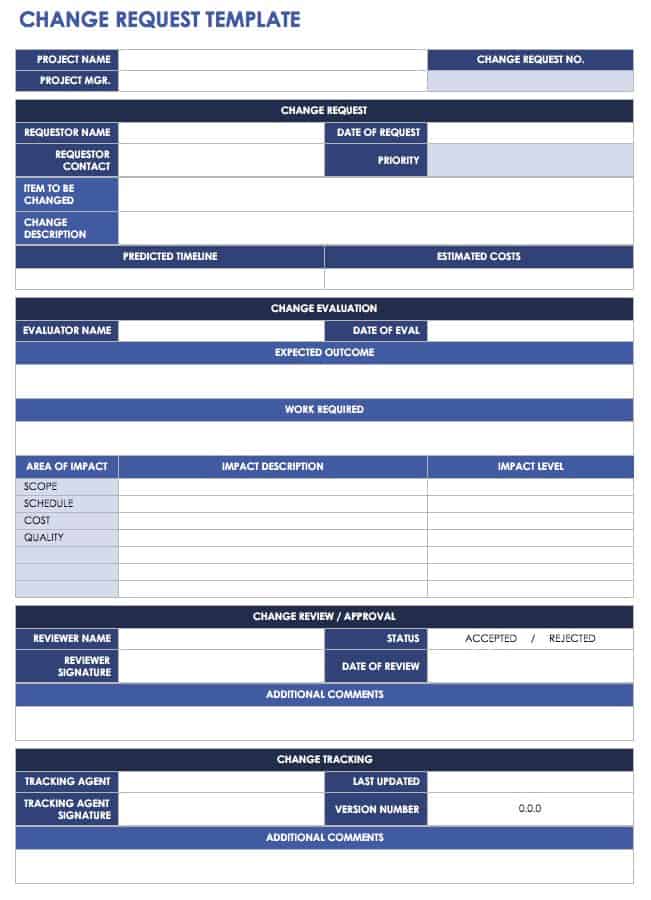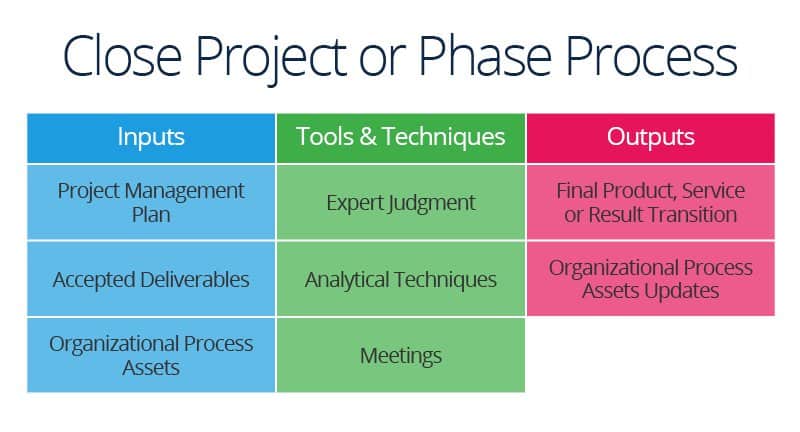What Is Project Integration Management?
Project integration management coordinates all the aspects of a project to ensure that it runs smoothly. Project managers juggle competing objectives, activities, and alternatives to meet stakeholders' needs. They use project integration management to coordinate different project processes and activities to ensure project success.
The Project Management Institute (PMI) identifies project integration management as one of 10 project management knowledge groups. It's part of the text, A Guide to the Project Management Body of Knowledge (PMBOK® Guide), a guide that identifies the standards of project management. Project integration management touches all of the processes of project management — initiation, planning, execution, monitor and control, and closing — making it the largest of the knowledge groups. Project integration managers will follow specific processes to fulfill their role.
Knowledge areas and processes are different from, but related to project integration management. A knowledge area includes the knowledge, processes, and outcomes (or deliverables) for a specific role. Processes are the specific steps and activities you must complete to achieve your goal. (For example, a car mechanic understands the knowledge area of car repairs, and follows a sequence of steps to fix your car.)
Any project plan must follow a series of processes to be successful. To understand the difference between a project and a process, think of it this way: A project has a beginning, middle, and end. A process is a specific series of steps that can be repeated over and over in any project.
Project Management Guide
Your one-stop shop for everything project management

Ready to get more out of your project management efforts? Visit our comprehensive project management guide for tips, best practices, and free resources to manage your work more effectively.
What Does Integration Mean in Project Management?
A project manager can execute any plan. Integration is essential for project managers who have to schedule tasks, evaluate resources, buy products, and manage outcomes for different project activities. Integration in project management means evaluating and making trade-offs among stakeholders, overlapping processes, or competing activities to successfully reach the goal.
Few projects touch only a single process or situation. You need project integration management when processes, people, and programs interact. For example, you it in the following situations:
- When project documents from different departments must be consistent
- When the project's work must be integrated with the continuing functions of the organization
- When deliverables from different departments or specialties (such as mechanical and electrical engineering) must be integrated
- When the project's scope and the product's scope must be integrated.
How to Succeed in Project Integration Management
General management skills such as planning, organization, communication, and leadership only determine part of your success in project integration management. You also need some basic technical knowledge to join discussions and guide decisions about the project or product. Even more, you immediately need to attain political organizational awareness to get buy-in from key stakeholders and team members: Interview various managers to understand their objectives and what they expect from your role and responsibilities, and use that information to begin to formulate a project plan. Remember to use the plan throughout the whole project: It is, in essence, the playbook for your project.
If you start with support and consensus, you will find it’s easier to guide the project as it touches different processes and departments. Every organization already has a set of standard, defined processes: Tailor those to the specific project so you can successfully integrate the project into the company. What’s more, you'll likely avoid roadblocks when trying to secure the funding and approvals you need for the project to succeed.
As you prepare your plan, tell key stakeholders how you will communicate throughout the project. You will build teamwork and trust when you share information on a regular basis and manage expectations about how you will communicate. By keeping them up-to-date on the status of the project, you honor the buy-in you earned from them at the beginning of the project, and manage their involvement.
As the manager, you should establish project teams, especially those that cross departments or functions. Project integration means incorporating the views and expertise of various stakeholders to ensure you don't miss key information or perspectives. Consider setting guidelines for these teams, including scheduled meetings or a shared communication strategy that uses a certain software program or reporting feature.
What Is the Scope of Project Management?
Integrated project management includes many of a project manager's responsibilities and roles. The scope of integrated project management covers the entire project:
- Project plan development, including the project charter, preliminary scope statement, and project management plan
- Project plan execution, including directing, managing, and monitoring the project as spelled out in the project plan
- Integrated change control, with formal processes for reviewing, implementing, and logging the changes required by the project
- Project close, with formal and informal reporting about how successfully the project was completed and the lessons learned
Identify the project's assumptions and constraints as you develop the project plan and outline the scope of the work. What do you assume the timeframe for the project will be? What resources will be available, and when? What is the involvement of the departments of your organization, including human resources? What external factors could affect your project, including economic or cultural assumptions? Projects can fail if you don't identify these assumptions. For example, consider how you will do the following:
- Train staff and managers
- Set and manage expectations
- Identify, document, and track project requirements
- Communicate your progress and changes
Identify the project manager as early as possible. By designating a PM early on, you keep your project on track toward a shared goal, avoid scope creep, meet deadlines and budgets, and help your team communicate effectively.
Your organization may consider using Project Portfolio Management (PPM) to collect, analyze, and report on all its projects. PPM gives your company the ability to identify any projects that need extra resources, as well as those that need to be recalibrated to meet their goals. When you choose PPM, however, consider how it will keep each project aligned with your organization's strategy, and identify and allocate the resources you need.
Value of Certification
To enhance your career, you can become a Project Management Professional (PMP): This earns you a certification in project integration management, which is recognized globally as an industry standard. Earning certification shows your commitment to your career in project management. You also can demonstrate your knowledge of the processes necessary for project integration management, which makes you more valuable to any organization and improves your job opportunities. Combined with a successful track record, certification shows that you — and the team you lead — can perform at the highest levels of success. As a bonus, the average annual salary in the U.S. for certified project managers is 20 percent more than those lacking certification, according to the ninth edition of the Project Management Institute’s Project Management Salary.
7 Steps in Project Integration Management
The goal of the project integration management process is to coordinate all the activities of any project. It uniquely touches all the phases or stages of the project: initiation, planning, execution, monitoring and control, and closure. This chart shows the seven processes of project integration management, the phases of the project each touches, and the key deliverables for each process.
Step One: Project Charter Process
The first step is the Develop Project Charter Process. This process kicks off the project and summarizes the goals, the steps to complete the project, the stakeholders, and the project manager. The project charter is a one-page document is the road map that will guide the entire project and is the contract with all the project's stakeholders.
This chart shows the inputs, tools and techniques, and outputs of the Project Charter Process.
A project charter is the key source of information about the project and defines its boundaries. It anchors the project. The elements of the chart should do the following:
- State the project title and description
- State your business's needs and business case
- List the project's objectives
- Outline the risks
- Identify project resources and technologies
- List the objectives and deliverables
- Describe the documentation requirements
- Identify the project manager and key stakeholders
- Include the roles and responsibilities of the project manager and team members
- Outline the budget
Another role of the project charter process is to gain buy-in, which gives the project manager the authority to implement anything within the scope of the project. The charter outlines the relationship with internal and external clients and represents the ways you will continue, as the manager, to communicate the project's progress.
Project selection methods can include the following numeric methods:
- Benefit Measurement Model (or Comparative Approach): The payback period and the cost-benefit analysis (rate of return).
- The Mathematical Model (or Constrained Optimization): Linear, multi-objective approaches to the project.
You may also use non-numeric methods to select the project. For example, senior leadership may want this project (a "sacred cow"), or this project may provide a competitive necessity. Get started creating a project charter with this template.
You can learn more about project charters and download more project charter templates from by reading Project Charter Templates and Guidelines for Every Business.
Step Two: Preliminary Scope Statement Process
The second process is to develop the preliminary scope statement. In this process, you identify what will and won’t be part of the project. This step will help you assign the best resources to successfully complete the project on time and on budget.
This chart shows the inputs, tools and techniques, and outputs of the Develop Preliminary Scope Statement Process.
This document gathers all the requirements of the project so you meet the defined objectives and deadlines. This process typically includes stakeholder interviews, an assessment of the factors that could influence the project, and a plan for measuring deliverables. The statement should include the following:
- Project objectives
- Goals
- Tasks
- Stakeholders
- Project requirements list
- Resources
- Budget
- Schedule
- Change request process
- Communication methodologies
The scope statement should be complete, accurate, and clearly defined, since it is your defense against scope creep. In project integration management, this document guides decision-making when changes are requested or when other unexpected events alter the project.
This document can also be considered a Statement of Work (SOW) or Terms of Reference (TOR) that is shared among stakeholders. It is the key reference when questions are raised or changes are requested. It provides direction for the project and a way to resolve disputes and avoid problems.
You can find a Statement of Work outline and template here.
Step Three: Project Management Plan Process
In the Project Management Plan Process, you develop the master plan for the project. This project management plan captures, defines, and combines all the planning documents and provides a baseline for scope, costs, and schedule. This plan guides the way you manage, execute, and control the project.
This chart shows the inputs, tools and techniques, and outputs of the Develop Project Management Plan Process.
This process integrates many of the PMBOK knowledge areas and consolidates other management plans including cost management, scope management, requirements management, schedule management, risk management, quality management, human resources, communication, stakeholder management and procurement management.
The plan should provide clarity to guide the project, but should also be flexible enough to evolve during its execution. It should ensure that everyone knows what is expected of them, and when. The best plans also ensure a culture of open communication among the team, and provide training to ensure each person's success and professional development.
One way to ensure that work is accomplished on time and on budget is with a Work Breakdown Structure (WBS). The PMBOK describes this element as a key project deliverable that breaks the work into a hierarchy of smaller steps. Each member of the project team knows the timeframe, budget, and deliverables for each step. The WBS shows the allocation of resources and provides a timeline that keeps everyone on the same page.
You can find several WBS outline and diagram templates here.
Other essential elements of the project management plan are baselines for schedule, cost performance, and scope. In project integration management, use these to monitor how closely the work aligns with the approved plan. Baselines may be formally changed, but any changes should be documented during the management of the project.
The project management plan should also gather any historical information (background about previous projects) that may guide the current work. These documents can include final reports about other projects, contracts, and SOWs that other teams used in previous projects, or informal discussions with those involved in past projects. Documentation about closed projects may help the project manager plan and execute the current work.
In the planning process, take into account the policies of the organizations involved in the project. For example, consider financial controls such as accounting codes, reviews of expenditures, and contract revisions. The project manager should be aware of the policies that govern audits, hiring and firing, and staff performance.
You may also consider using a Project Management Information System (PMIS) to create the project's timeline, allocate resources, and track project steps. Project management software can help you plan and monitor the project in real time, from any location. When you consider software, make sure each team member will have access and training to use the system regularly — otherwise your reporting updates will not be accurate or timely.
Once the plan is developed, stakeholders and team members should meet to ensure buy-in, communicate the goals and deliverables, and formally launch the project. The scope statement or project plan should identify a process for changes. The project manager will consider any changes through the framework of the project objectives and goals.
Be aware in this process that there are factors that will limit the plan. For example, the established budget can limit the scope, cost, staff resources, and schedule. Other constraints include geographical conditions, legal policies, and cultural issues. You should be willing to make tradeoffs among these constraints. The biggest challenge may be in managing the opinions of key stakeholders and their expectations of the project as it is implemented. That's why the kick-off meeting is essential to manage expectations and the process for resolving any changes or conflicts.
Step Four: Direct and Manage Project Work Process
The Direct and Manage Project Work Process focuses on executing the project plan. Team members complete the tasks assigned and the project manager integrates all the activities into the overall project according to the defined objectives. This process is the day-to-day work of project management and includes answering questions, conducting status meetings, providing updates to stakeholders and directing the team.
This chart shows the inputs, tools and techniques, and outputs of the Direct and Manage Project Work Process.
The goal of this process is to keep the project on track. Be proactive in looking for deviations in the plan and quickly identify any corrective actions. There are two approaches:
- Preventive Action: A way to keep an activity aligned with the project management plan.
- Corrective Action: A response after an activity falls out of line with the plan.
As the team implements the plan, you may get reports about defects in project components. A key step in this process is to identify whether you can modify the component (a defect repair) or will have to to replace it. Keep in mind that either of these actions can affect the schedule, budget, and quality of the project.
Don’t be surprised if you see change requests as the project is put into action. These requests come through the Monitor and Control Process (see below). Your project should have an authorization system that describes who makes the decision about changes in scope, budget, timelines, deliverables, corrective actions, and so on. Once a change has been formally approved, Direct and Manage Project Work Process implements it.
One way to avoid scope creep during this process is to have a clear understanding of the Enterprise Environmental Factors (EEF) of your project. If you have clearly identified the culture and structure of your organization, the regulatory market, and your project’s customers, you have a guide to direct and manage the project.
Step Five: Monitor and Control Project Work Process
The Monitor and Control Project Work Process and the Direct and Manage Work Process are closely related. Both steps involve execution, track the implementation of the project, and provide inputs to the Integrated Change Control Process (the following step). The difference is that in this process, you will control the scope, schedule, costs, quality, communications, risks, procurements, and stakeholder engagement.
This chart shows the inputs, tools and techniques, and outputs of the Monitor and Control Project Work Process.
In this stage, the project manager reviews, documents, and reports on the status of the project. One key responsibility is to continually measure the project’s status: Where are you on time and budget? Where are you falling behind? The data you gather serves two functions: It helps avoid scope creep if the project seems to expand beyond its original objectives, and highlights any problem areas that will need corrective action.
The project manager controls the project, but also may need to create change requests during this process to meet the plan’s performance objectives. These requests typically go through the Perform Integrated Change Control Process for review. If the change is approved, it will be implemented through the Direct and Manage Work Process, and the planning documents should reflect those changes.
In project integration management, you evaluate changes from various work units and weigh individual changes against the overall deliverables of the project. Be willing to make trade-offs between stakeholders to ensure the quality and timeliness of the entire project.
Step Six: Integrated Change Control Process
The Perform Integrated Change Control Process ensures that any request for a change in the project is received, reviewed, and accepted or rejected according to the goals of the project and the organization’s guidelines. Changes can range from a shift in schedule or budget to reports about substandard product components or activities that affect the quality of the project.
This chart shows the inputs, tools and techniques, and outputs of the Perform Integrated Change Control Process (also known as the Change Management Process).
The project manager must evaluate any change in light of the entire project to help avoid scope creep. The project manager must then adjust related project baselines, and document and communicate the change with relevant stakeholders. In project integration management, each knowledge area is updated with any related changes with supporting documentation. Typically, these changes are then added to the Direct and Manage Project Work Process for implementation.
The project charter or scope statement should define the process for reporting and reviewing changes, so that all the stakeholders agree on the change control system long before the first change occurs. This system ensures that the project will run more smoothly and that all changes are part of an integrated management approach. When conflicts arise, it should provide some structure over the priority of changes and the scope of the work as it relates to the entire project. A change control system should include the following:
- The team member or project liaison who can approve or authorize a change
- The form the request should take (whether submitted in the project management software, an email, or a change request form)
- The standards used to review the change
- The timeframe for reviewing changes
- The notification and communication process when the change is approved or rejected
- The steps for documenting the change and adding it to the Direct and Manage Project Work Process
Download a Change Request Template
Some organizations create a formal change control board to review change requests as part of the change control system. Even small projects can benefit by having a group of people reviewing each request, suggesting alternatives, or getting buy-in for any necessary change.
During the project, use a change control log or change form to track all the change requests. This document gives you essential data about the number of changes, the types of changes requested and approved, the costs and staff resources associated with each request, and the effect on the project’s timeframe. You can also use this form to ensure that communication continues after the change has been approved. The log provides a summary of changes in progress, and also offers a checklist to ensure that the relevant stakeholders have been notified of changes and their impact on the project.
Change requests will come up during the execution phase of the project, particularly in the Monitoring and Control Work Process. It is the role of the Integrated Change Control Process to review the changes, and decide how to implement and communicate them to project stakeholders.
Step Seven: Close Project or Phase Process
Once the project is complete, you will conduct the Close Project or Phase Process. In this process, you produce a formal review of the project, its successes and struggles, and lessons learned. This formal report should document the project’s success, offer key data points as a historical document for future projects, and build a stronger foundation for continued project integration management in your organization.
This chart shows the inputs, tools and techniques, and outputs of the Close Project or Phase Process.
To close the project, you must conduct a final review of the project. Gather and archive all the final documents (such as inspections or procurement releases), written approvals in contracts that formally consider the project complete, and other files produced during the project. Here are a few steps to follow when auditing the deliverables and assessing the project’s outcomes:
- Confirm that the work is complete
- Gain final acceptance of the project and solicit feedback from the customer
- Complete financial reports
- Close the procurements process
- Index and archive all project contracts, files, and change documents
- Create a final performance assessment
You should also consider holding a project review, similar to an employee performance review. Gather a formal or informal group to review what did and didn’t work, and what you learned from changes and missteps. In this lessons learned report, identify the takeaways and how you can use those in the next project. Not only will you be more effective in the future, but you also will also build teamwork by seeking the opinions and insight of others on the project. These may be the greatest benefits of improving integration in future projects.
Integration Between Project and Change Management
The discipline of project management focuses on the technical aspects of completing the work and meeting an organization’s goals. On the other hand, change management focuses on the human factors that companies need to manage change in a process, product, or business. While the two disciplines will intersect at times over the course of a project, in a typical organization they work independently.
As a project manager, consider ways to integrate the two to drive success, cover every project and personnel detail, and inspire deeper collaboration in your organization. Here are four ways to integrate project and change management:
- Roles, Responsibilities, and Relationships: Map out the relationship between the project team and change management resources. In your structure, establish the roles and responsibilities of each team member and how everyone supports change management, as well as the project development.
- Milestones and Deliverables: Designate what work is being done at each level and stage of the product life cycle. Project management already is driven by deliverables, as is strong change management. Integrating the processes creates enthusiasm about the project and its development.
- Tools that Already Work: You can easily adapt what you use in project management — such as risk assessments, communications plans, and stakeholder interviews — for change management. In addition, you can demonstrate how effective change management insight and analysis can improve the technical aspects of the project.
- Integrated Project Delivery or Methodology: When you create a shared set of steps, you can anticipate obstacles more quickly and discover fresh approaches to solutions.
You would consider this integration because you create a nimble, forward-looking team structure that can innovate more quickly, adapt to changes with greater ease, and improve the performance of the entire organization.
Improve Project Integration Management with Smartsheet
From simple task management and project planning to complex resource and portfolio management, Smartsheet helps you improve collaboration and increase work velocity -- empowering you to get more done.
The Smartsheet platform makes it easy to plan, capture, manage, and report on work from anywhere, helping your team be more effective and get more done. Report on key metrics and get real-time visibility into work as it happens with roll-up reports, dashboards, and automated workflows built to keep your team connected and informed.
When teams have clarity into the work getting done, there’s no telling how much more they can accomplish in the same amount of time. Try Smartsheet for free, today.

